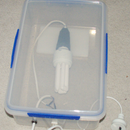Introduction: Green Laser Pointer
In this project, I built a solid enclosure for a green laser module I brought from futurlec for $15 AUD. This was in response to an older laser module of mine being damaged.
The old laser module's enclosure was inadequate, and I wanted the new one to be sturdier, as well as having options to run the laser in continuous mode as well as push-button mode.
Step 1: Materials and Equipment
Materials used were:
1 green laser module. (This particular module takes 5V to run.)
1 double pole, single throw switch.
1 momentary button.
1 4AA battery pack.
2 40mm PVC end caps.
1 short section of PVC.
1 40x40 piece of polypropylene plastic. (from a cutting board).
3mm metric fasteners. (Small bolts.)
Shrink wrap.
Solder.
Equipment used were:
Drill press. (I actually used a mini drill-press that takes a hand drill.)
Dremel with cutting disks and sanding wheel attachments.
Soldering iron.
Blow torch.
Step 2: Drilling and Cutting Plastics.
I was 1/3rd of the way through the project before I thought to start an instructable. Most of the early stages are pretty simple however.
1. Drill a hole large enough to fit the laser module into the end of one of the PVC end caps.
2. Losely fit the laser module into the end cap, and attach to the PVC pipe.
3. Using the laser module as a depth guide, place two holes for the switch and button just past the module's end.
4. Remove the end cap, and remove the laser module for safety.
5. Using the cutting and grinding dremel tools, cut the polypropylene into a disk that fits inside the PVC pipe. Cut a notch into the disk to allow the electrical cords through.
6. Insert the polypropylene disk into the PVC pipe, just past the holes for the buttons, and drill three 3mm holes through the PVC, into the polypropylene. This is where the metric fasteners will be added to hold the disk in place in future steps.
7. Place the battery pack into the other end of the PVC pipe so it touches the polypropylene (Opposite the laser module end of the pipe.) and use it to mark the required length of pipe.
8. Remove the battery pack, and cut the pipe to length using the dremel.
9. Place both end caps onto the pipe and drill three 3mm holes through the sides of the end caps into the PVC pipe.
10. Finally, remove the polypropylene and end caps, ready for the final construction stages.
The picture below shows what the plastic parts will look like once you're finished.
Step 3: Soldering
The switch and button are wired in parallel, and then attached to the laser module and battery pack. All connections are covered in shrink wrap that was shrunk into place with the blowtorch.
(Except for the one bare terminal that had the shrink wrap too close to the iron while I was soldering. I had to cut it off because it shrunk into the wrong spot.)
This particular laser module seems to be one designed for a pen-type container, and to have direct contact with the batteries. The switch on the module is actually short-circuited by the red and black wires that it came attached to. This suggests to me that the manufacturer repurposed these modules for the electrical hobbyist. Since I was going to do this anycase, I'm not complaining.
Step 4: Circuit and Disk
The wires from the battery pack are placed into the slot in the polypropylene disk.
Then the battery and disk are fed into the PVC pipe until the disk is in line with the middle row of holes. The disk is fixed in place using metric fasteners. In the second image below, you can see where I've left one fastener out the side.
Polypropylene is very easy to screw into and forms a tight fit, removing the need to use nuts on the ends of the fasteners.
Step 5: The Magic of Hot Glue.
The laser module is inserted into the PVC end cap with the hole and stuck in place with LOTS of hot glue.
Step 6: Fitting Switch and Button.
This was the fiddly bit. There is only about 40mm of free space inside the pipe, and I have REALLY thick, stubby fingers. :-(
The switch and button are pushed through the holes and locked in place using nuts and washers. Then the PVC end cap with the module is pushed into place and locked with metric fasteners.
Note that I made sure there was enough length on the battery pack cords that it could be pulled out from the other end of the container.
Step 7: Moooooreeee Power.
Here I am putting the batteries into the battery pack.
The batteries I used are rechargable Eneloops. They take a night to charge, but stay charged for up to a year if you leave them lying around. The only hastle is that they only give 1.2V. This is why I used 4 to charge the 5V laser module. We will see if they have enough voltage to keep the laser running for long periods of time. Needless to say I'm NEVER using 1.5V alkalines with this project.
Step 8: Padding for the Battery Pack.
I slid the battery pack into the PVC pipe, padded the pack with some cotton wool, and then attached the other PVC end cap and screwed in the metric fasteners.
Step 9: Final Product
And done.
If the switch is flipped forward, the laser module turns on and stays on.
Edit: There seems to be a bit of a problem with the module heating up in continuous use mode. The laser module comes with inbuilt thermal regulation and the laser gets dimmer with long term use. I'll add on my solution to this once I find something that works.













